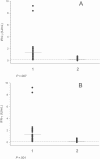Detection of IFN-γ Secretion in Blood Samples Collected Before and After Treatment of Varying Stages of Lyme Disease
- PMID: 34043758
- PMCID: PMC8528399
- DOI: 10.1093/cid/ciab503
Detection of IFN-γ Secretion in Blood Samples Collected Before and After Treatment of Varying Stages of Lyme Disease
Abstract
Background: QuantiFERON enzyme-linked immunosorbent assay (ELISA; Qiagen) with Borrelia burgdorferi peptide antigens was previously shown to reliably detect interferon-γ (IFN-γ) in blood samples from adult patients with early Lyme disease and the response disappeared rapidly after treatment. We evaluated the response before and after appropriate antibiotic therapy in adolescent and adult subjects with more diverse stages of the illness.
Methods: Blood was obtained from patients with clinician-identified Lyme disease with constitutional complaints, erythema migrans, nerve palsy, cardiac abnormality, or arthritis before (n = 68) and 6 weeks (n = 46) and 6 months (n = 45) after therapy. The sera were tested for Lyme disease by standard 2-tiered testing (STTT) and anti-C6 antibodies by ELISA and the levels of IFN-γ in the blood samples were detected by QuantiFERON ELISA.
Results: A positive STTT result supported the clinical diagnosis of 37 (54%) subjects and anti-C6 antibodies were detected in 45 (66%) subjects, including 36 (97%) STTT-positive subjects, and the responses often persisted or expanded after antibiotic therapy. IFN-γ was detected in 49 (72%) subjects prior to treatment and the response most often significantly decreased 6 weeks (P = .007) or 6 months (P = .001) after treatment.
Conclusions: The QuantiFERON ELISA reliably detected IFN-γ in blood samples from adult and adolescent patients with varying stages of Lyme disease and the response disappeared rapidly after treatment. Additional studies to more critically evaluate clinical utility as a laboratory test for diagnosis and confirmation of effective therapy are warranted.
Keywords: Borrelia burgdorferi; IFN-γ; Lyme disease; T cell; cytokine release assay.
© The Author(s) 2021. Published by Oxford University Press for the Infectious Diseases Society of America. All rights reserved. For permissions, e-mail: journals.permissions@oup.com.
Figures

References
-
- Stanek G, Strle F. Lyme borreliosis-from tick bite to diagnosis and treatment. FEMS Microbiol Rev 2018; 42:233–58. - PubMed
-
- Bratton RL, Whiteside JW, Hovan MJ, Engle RL, Edwards FD. Diagnosis and treatment of Lyme disease. Mayo Clin Proc 2008; 83:566–71. - PubMed
-
- Nadelman RB, Wormser GP. Lyme borreliosis. Lancet 1998; 352:557–65. - PubMed
-
- Nowakowski J, Schwartz I, Liveris D, et al. ; Lyme Disease Study Group . Laboratory diagnostic techniques for patients with early Lyme disease associated with erythema migrans: a comparison of different techniques. Clin Infect Dis 2001; 33:2023–7. - PubMed
Publication types
MeSH terms
Substances
Grants and funding
LinkOut - more resources
Full Text Sources
Other Literature Sources
Medical

